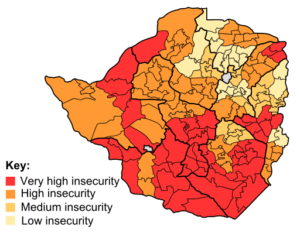Venezuela and Zimbabwe

…

…

According to Colombians who were interviewed in the video, criminals can ask someone to smell the powder, and the drug is so potent that it will take effect when they sniff. The video contains a series of interviews, including a taxi driver who seems to know all too much about the drug, and some people who were victimized using it. Still, the stories were so extraordinary that I couldn’t help but wonder, could this possibly be true? Can victims truly lose their will, so that they will assist a robber to burglarize their home? Or is this partly folklore? Vice’s reporter Ryan Duffy did not appear to be someone with a deep knowledge of Colombia. Nonetheless, the interviews with authorities, including the police and a doctor, were very convincing. Nonetheless, I wondered how to judge where reality ended and folklore began. After all, this drug is used in Western medicine to treat some conditions such as motion sickness? Wouldn’t this effect be familiar from this usage? Or are there differences between scopolamine and the the drug variant used …

In the 1980s the global media gave extensive coverage to deforestation in Amazonia. Over the last thirty years, there has been a significant decline in media attention to this topic, which partly reflects very real progress that Brazil and neighboring countries have made in slowing deforestation. Still, the problem remains. In 2014, Brazil decided not to sign a UN agreement to defend forests.
I’ve been teaching a course on Amazonian history for 20 years, and I’ve never found such a good classroom resource on the topic as this storyboard by the Council on Foreign Relations. The storyboard combines small amounts of text, with imagery and short videos to place the issue into historical context. Many of the pages are dynamic; that is, there is movement in the background. Some of the maps are excellent. I also particularly liked the successive aerial shots of forest in the Brazilian state of Rondonia over ten year increments.
One weakness is that the storyboard focuses only on Brazil. While Brazil is the country that on its own has the largest Amazonian territories, it would have been useful to have more information on Bolivia, Peru, Colombia and Venezuela as well. I also personally believe that dams are perhaps the greatest environmental threat in the region, and would like to have seen more coverage of this issue in the storyboard. Still, for any class that addresses environmental issues, this would be a great link in a course shell.
Shawn Smallman, 2017
![By Sparkve (Own work) [CC BY-SA 3.0 (http://creativecommons.org/licenses/by-sa/3.0)], via Wikimedia Commons. Please note the territory in red, which belongs to Guyana but is claimed by Venezuela. In 2015 Exxon discovered oil in this region.](https://www.introtoglobalstudies.com/wp-content/uploads/2016/12/512px-Mapa_Venezuela_Topografico-300x263.png)
![Cristina Fernández de Kirchner, President of Argentina in her role as Commander in Chief of the Armed Forces, carrying a Rechkemmer. Presidencia de la Nación Argentina [CC BY 2.0 (http://creativecommons.org/licenses/by/2.0)], via Wikimedia Commons](https://www.introtoglobalstudies.com/wp-content/uploads/2016/11/Cristina_Fernandez_Comandante_en_Jefe.jpg)
Academics dislike conspiracy theories, which are typically omitted in social science theory classes, even though they are far more influential than the theories of Gramsci, Weber and Durkheim. There are many reasons for academics’ distrust of these theories, not the least of which is their historical association with political and ethnic persecution. At the same time, conspiracy theories are true “theories,” in that they provide an overarching framework for understanding the world. While they don’t have foundational writers, they also have their texts. They also emerge from the folk and not from intellectuals, and accordingly provide insight into popular attitudes, beliefs and fears. …
Today I gave a talk at the World Affair’s Council in Portland on the upcoming impeachment process in Brazil. Brazil’s Senate will vote in May on whether to initiate a trial against President Dilma Rousseff. A simple majority vote within the Senate will be enough to remove her from power for 180 days, while it considers her case. In that event, the Senate would then have to vote by two-thirds to impeach the President. If this were to happen, what would then occur next? …
For any readers who live in Portland Oregon, I am giving a talk for the World Affairs Council on Brazil’s move to impeach the President. The session will place next Wednesday, April 27th at noon, and registration is required. You can find more information and register at this page on World Affairs Council website. To see my own book on military terror in Brazil, click here.
Shawn Smallman, 2016
In Brazil a female news presenter was the target of racist comments online after the show posted her picture to Facebook. In response, people posted these comments on billboards near the authors’ houses, without giving their names. This brief video shows the billboards and interviews people about their reaction to these comments. Although the people speak in Portuguese, the video is subtitled in English. The slogan at the bottom of the billboards says “Virtual Racism: the consequences are real.” At a time when racial justice is a pressing issue in the United States, it’s interesting to examine how people in another nation are addressing racist speech. The video also raises the issue of how people adopt new personas online, because they perceive that different standards of speech apply, and they can act with impunity.
To see my own book on military terror in Brazil, please click here.
Shawn Smallman, 2016
I’ve been studying Brazil for nearly 25 years now, and have seen the country pass through many difficult times. For all the bad news regarding Brazil, the nation is still in a very different place than in 1992-93, when inflation was perhaps 1,700 percent annually, and the clerk at the post office had to use a calculator to figure out what a stamp cost on that particular day. A very poor graduate student, I used to change my money late in the week, in the hope that the grocery stores had not had enough time to raise their prices. It was always disappointing to get to the store and see that the stock clerks had changed prices in advance of my arrival. I was also in Rio de Janeiro was President Fernando Collor de Mello was impeached in 1992. For this reason, I tend to take a skeptical look at bad news from Brazil, which often overlooks the many real advances that are being made. Still, it’s hard not to feel pessimistic right now. A recent article in the Economist describes the immense economic and political challenges that Brazil faces. Given Brazil’s importance to Latin America, this piece is worth reading. If you want something a little more uplifting, though, listen to this Planet Money podcast about how Brazil tamed its terrible problem with inflation.
If you are interested in Latin America, you might wish to read either my book on the region’s AIDS epidemic, or my study of military terror in Brazil.
Shawn Smallman, Portland State University, 2016

The health news from Brazil is truly remarkable, as the Ministry of Health is advising women in the northeast not to become pregnant at this time because of the emergence of a new disease in the Americas called Zika fever. Historically, Zika fever has been a very rare disease, which until 2007 had caused only a small number of diagnosed cases in Africa and Asia. The Zika virus was native to the forest of Zika in Uganda, where it circulated amongst monkeys. The disease suddenly appeared in 2007 in Micronesia, then spread to French Polynesia in 2013, followed by Easter Island in 2014, before finally arriving in Brazil. The disease causes many of the same symptoms as dengue (high fever, headache, joint and muscle pain, nausea, stomach pain, exhaustion, pain in the back of the eyes, conjunctivitis, a maculopapular rash, and swelling of the legs). This is unsurprising because dengue and the Zika virus are members of the same viral family (flaviviridae), and are both spread by the same species of mosquitoes, particularly Aedes aegypti and Aedes albopictus. There is no treatment or vaccine for Zika fever.
When it first appeared in Bahia, in northeastern Brazil, in April 2013, it was not immediately obvious that this was a new disease. As patients were tested for dengue, however, and the results came back negative, the medical system soon realized that something unusual was happening. While worrying, the disease did not seem disastrous when it appeared in Brazil. People can be infected with Zika fever only once. The symptoms typically last four to seven days, then the patients recovers. In some cases, patients suffer from immunological or neurological disease (Guillain-Barre syndrome) as a result of their infection, but this is atypical. When it appeared, the disease seemed to be less serious than dengue. Very few people have died from it in Brazil. As the epidemic continued, however, doctors began to report a bizarre increase in the number of babies born with a serious birth defect, microcephaly. This disorder is characterized by a reduction in the size of the head of the baby. The rate of this disorder has increased sharply, perhaps ten-fold over the last year. Some doctors at Brazil’s Hospital Oswaldo Cruz are now suggesting that the problem is unrelated to Zika fever, but rather is tied to another emerging infectious disease in the region, Chikungunya. …